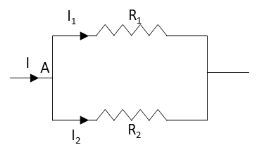
Answer
430.2k+ views
Hint:The word “equivalent” means the total. To derive the expression for effective resistance in the parallel combination of the two resistors, draw the circuit diagram of the two resistors connected parallel to each other. Use Kirchhoff’s current law to express the current at the junction to derive the expression.
Complete step by step answer:
Equivalent resistance is nothing but the total resistance in the circuit. If we connect the number of resistors one after another to the same wire, the total resistance of the wire increases because the resistance of each resistor adds up. Also, when we connect the number of resistors parallel to each other, the total resistance of the circuit decreases. Thus, we can say that the equivalent resistance is the resistance encountered by the whole circuit.Let the two resistors are connected in parallel combination as shown in the figure below.

We know that the voltage in the parallel arm remains the same. Therefore, the voltage across the resistor \[{R_1}\] and the voltage across the resistor \[{R_2}\] is the same.Applying Kirchhoff’s current law at the junction A in the above circuit, we get,
\[I = {I_1} + {I_2}\]
Using Ohm’s law, we can write the above equation as,
\[\dfrac{V}{{{R_{eff}}}} = \dfrac{V}{{{R_1}}} + \dfrac{V}{{{R_2}}}\]
Here, \[{R_{eff}}\] is the effective resistance of the two resistors and V is the voltage which is the same across the two resistors.
Simplifying the above equation, we get,
\[\dfrac{1}{{{R_{eff}}}} = \dfrac{1}{{{R_1}}} + \dfrac{1}{{{R_2}}}\]
\[ \therefore {R_{eff}} = \dfrac{{{R_1}{R_2}}}{{{R_1} + {R_2}}}\]
This is the required expression for the effective resistance of the two resistors connected parallel to each other.
Note:Students can also derive the expression for effective resistance in the series combination of the two resistors in the same manner as we have done in the above section. Remember, the current remains the same in series combination and the voltage remains the same in parallel combination. This is the key to derive the expression for both effective resistances in the series combination and the parallel combination. Also, students should remember KVL and KCL.
Complete step by step answer:
Equivalent resistance is nothing but the total resistance in the circuit. If we connect the number of resistors one after another to the same wire, the total resistance of the wire increases because the resistance of each resistor adds up. Also, when we connect the number of resistors parallel to each other, the total resistance of the circuit decreases. Thus, we can say that the equivalent resistance is the resistance encountered by the whole circuit.Let the two resistors are connected in parallel combination as shown in the figure below.

We know that the voltage in the parallel arm remains the same. Therefore, the voltage across the resistor \[{R_1}\] and the voltage across the resistor \[{R_2}\] is the same.Applying Kirchhoff’s current law at the junction A in the above circuit, we get,
\[I = {I_1} + {I_2}\]
Using Ohm’s law, we can write the above equation as,
\[\dfrac{V}{{{R_{eff}}}} = \dfrac{V}{{{R_1}}} + \dfrac{V}{{{R_2}}}\]
Here, \[{R_{eff}}\] is the effective resistance of the two resistors and V is the voltage which is the same across the two resistors.
Simplifying the above equation, we get,
\[\dfrac{1}{{{R_{eff}}}} = \dfrac{1}{{{R_1}}} + \dfrac{1}{{{R_2}}}\]
\[ \therefore {R_{eff}} = \dfrac{{{R_1}{R_2}}}{{{R_1} + {R_2}}}\]
This is the required expression for the effective resistance of the two resistors connected parallel to each other.
Note:Students can also derive the expression for effective resistance in the series combination of the two resistors in the same manner as we have done in the above section. Remember, the current remains the same in series combination and the voltage remains the same in parallel combination. This is the key to derive the expression for both effective resistances in the series combination and the parallel combination. Also, students should remember KVL and KCL.
Recently Updated Pages
10 Examples of Evaporation in Daily Life with Explanations

10 Examples of Diffusion in Everyday Life

1 g of dry green algae absorb 47 times 10 3 moles of class 11 chemistry CBSE

What is the meaning of celestial class 10 social science CBSE

What causes groundwater depletion How can it be re class 10 chemistry CBSE

Under which different types can the following changes class 10 physics CBSE

Trending doubts
Fill the blanks with the suitable prepositions 1 The class 9 english CBSE

Which are the Top 10 Largest Countries of the World?

How do you graph the function fx 4x class 9 maths CBSE

Differentiate between homogeneous and heterogeneous class 12 chemistry CBSE

Difference between Prokaryotic cell and Eukaryotic class 11 biology CBSE

Change the following sentences into negative and interrogative class 10 english CBSE

The Equation xxx + 2 is Satisfied when x is Equal to Class 10 Maths

In the tincture of iodine which is solute and solv class 11 chemistry CBSE

Why is there a time difference of about 5 hours between class 10 social science CBSE




